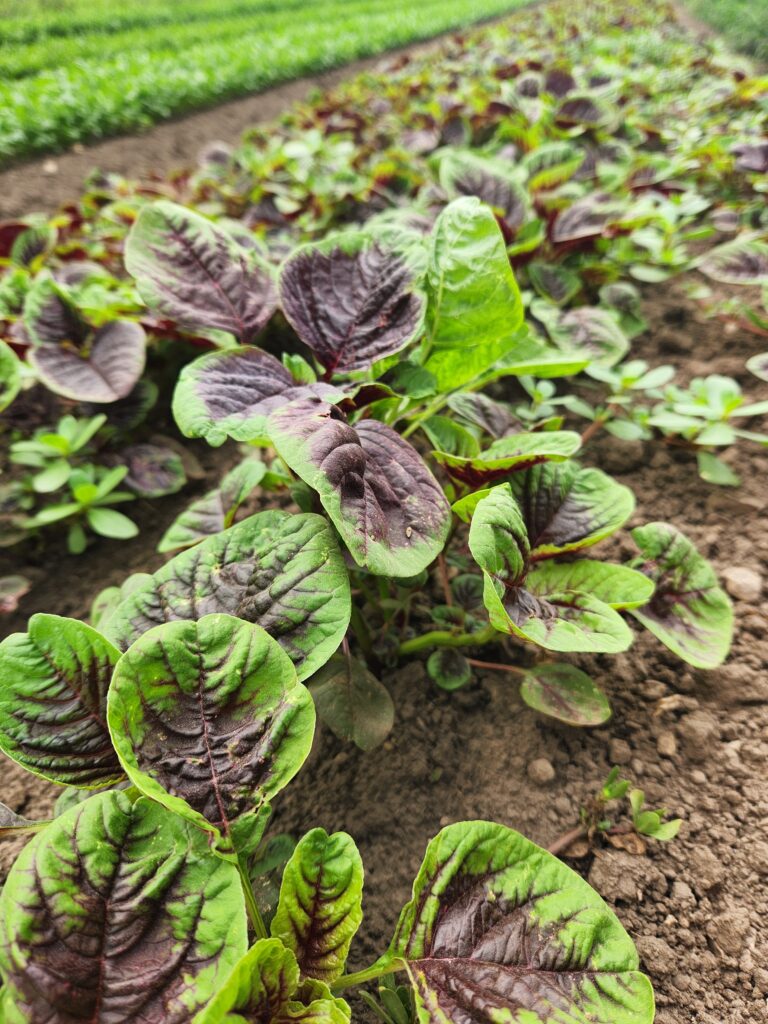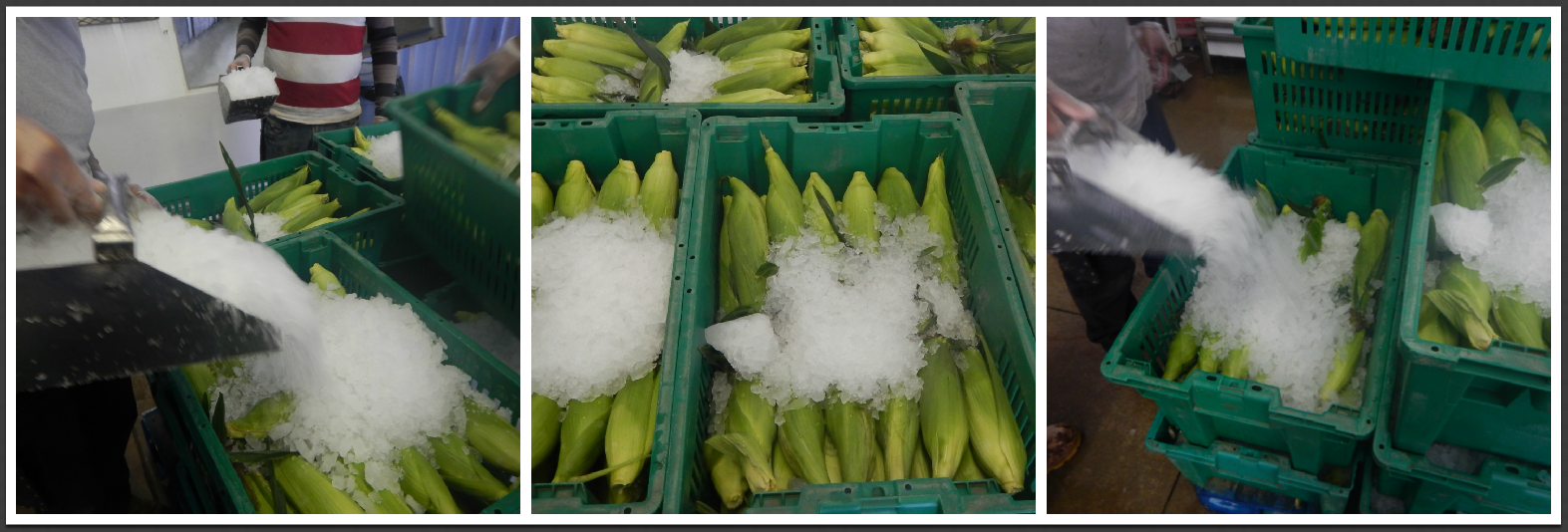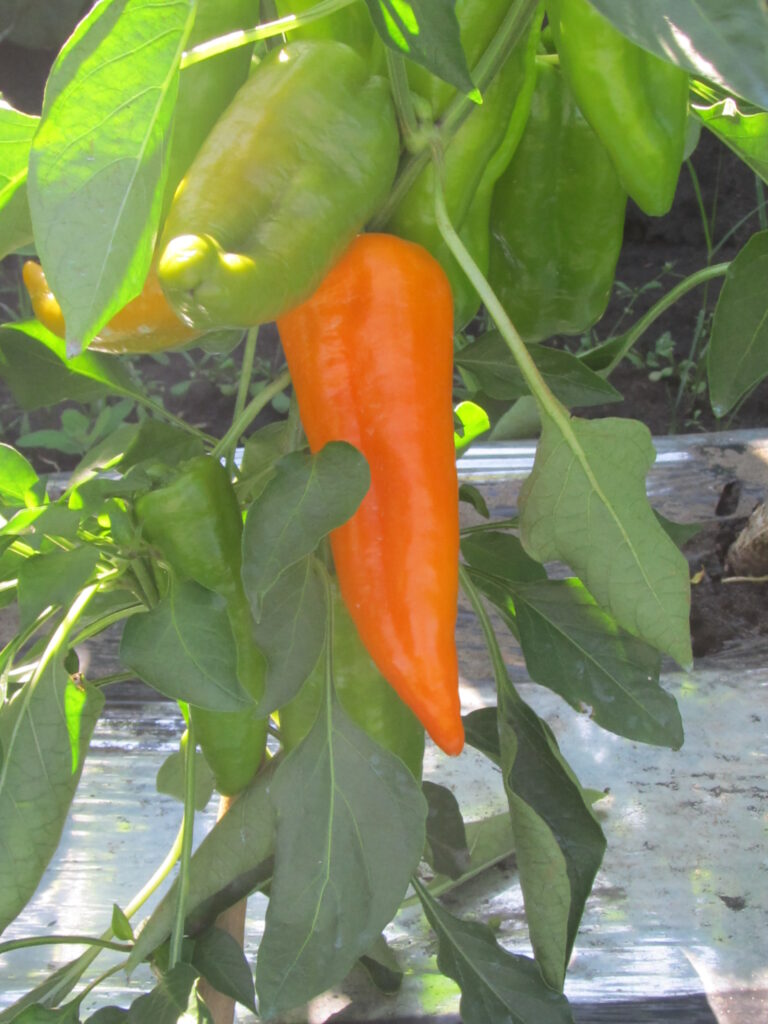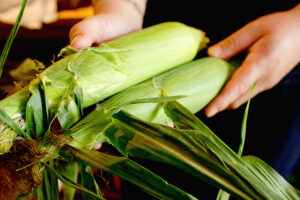What’s In The Box with Recipe Suggestions

Bi-Colored Amaranth Greens: Here is what the seed catalog has to say: “A heat- and drought-tolerant green with spectacular splashes of color! This leafy “spinach” amaranth is popular in Asia and is eaten raw, stir-fried, or steamed. This is by far the most tender and sweetest amaranth for edible greens, making for a vibrant and delicious salad. The young leaves are a perfect spinach substitute; the intricately colored leaves are juicy and succulent. This is the go-to “green” for midsummer when all others have bolted.”
Green Top Red Beets: Take advantage of the nutrient dense beet greens and use them in pasta dishes such as this recipe for Beet Pesto & Greens Pasta.
15 Creative Ways to Use Beet Greens
Carrots: Wash and trim these tender, sweet carrots and put them in a clear jar. Put them in a prominent place in the refrigerator so they’re available and visible for a quick and easy snack.
Green and/or Silver Slicer Cucumbers: Cucumber Raita is a simple condiment often served with Indian food. It’s a mixture of yogurt and cucumbers as well as fresh herbs that are a nice, cooling complement to spicy, full-flavored dishes.
Edamame: It’s easiest to remove edamame from their pods after they’ve been cooked. You can also preserve them for later use by freezing them. Cook the beans in boiling water for 3-4 minutes, then cool in ice water. You can freeze edamame in its pods or remove the beans and discard the pods before freezing.
Fried Rice with Edamame and Corn
Italian Garlic: Cut a clove of garlic in half and rub it on grilled, buttered bread to make a tasty, mild garlic toast.
Tomato, Zucchini Corn Pie with Almond Crust
Sun Jewel or Sugar Cube or Sweet Sarah Melons: All boxes will contain a small, personal-sized cantaloupe. It’s going to be a brief, but hopefully sweet, melon season this year! Store your cut up melon in the refrigerator.
Red & Yellow Onions: We are transitioning to some of our red storage and yellow Spanish onion varieties. You may notice these onions are firmer and have thicker skins, traits that lend themselves to a longer shelf life.
Green Bell and/or Italian Frying Pepper: This week’s box will contain either Orange/Red Italian Frying peppers (long, slender peppers) and/or Green Bell pepper. Both are considered sweet peppers.
Red Pepper, Lentil & Tomato Salad
Cheeseburger Pie with Roasted Poblanos and Corn
Poblano Peppers: Poblanos are the dark green, blocky pepper with a pointy bottom in this week’s box. This is a hot pepper with medium heat.
Cheeseburger Pie with Roasted Poblanos and Corn
Carola Gold Potatoes: This week’s potato variety is Carola, an early season gold skin, gold flesh potato that has a moist waxy flesh. Use for roasting, boiling, soups and chowders as well as potato salad.
Pan Fried Potatoes & Green Beans
Sweet Corn: This week and next week look like they’re going to be our peak sweet corn weeks! You need to keep your sweet corn cold to preserve its sweetness and we recommend eating it within a day or two for the maximum flavor.
Cheese Tortellini with Tomatoes and Corn
Sun Orange, Chocolate Sprinkles, or Red Grape Tomatoes: The cooler temps slowed down the ripening process, but we are still seeing lots of green fruit on the plants.
Large Tomatoes: For best results, eat ripe tomatoes shortly after receiving and ripen tomatoes on the counter at room temperature.
Green and/or Italian and/or Yellow Scallopini Squash: We are seeing some slowing down in the zucchini fields. Enjoy this week’s zucchini with one of the pie recipes below!
Vegetable Feature: Sweet Corn

We’ve said it before (probably every year), but ‘summer isn’t summer without sweet corn’! We work really hard to grow the sweetest, best tasting corn we can! Sweet corn is not always the easiest crop to grow. Variety selection is a big part of the picture and there’s also the issue of pest control because, unfortunately, we are not the only creatures who like to eat sweet corn in the spring or summer! This year we had birds stealing the seed corn right after we planted it, not even giving it a chance to start growing. We have had to employ multiple methods to keep your sweet corn safe. We have a cannon in the field that fires (noise only, no projectile objects) periodically to scare the birds. We also have a laser that was effective at deterring birds in the strawberry field earlier this year. Additionally, we have reflective streamers, scare-eye balloons and some hawk and owl decoys to deter the birds. Despite all these efforts, the birds have still done some damage, but hopefully it will be kept to a minimum. We also have a tall fence to keep deer and raccoons out of the field, but raccoons are tricky and usually can find a way to go under the fence. Thus, we also have a low electric tape around the perimeter of the field. As you can see, we do quite a lot to ensure we have sweet corn for your boxes!
Sweet corn is a crop you can’t rush, it’s ready when it’s ready and you just have to do your best to determine when it’s at its optimal maturity. Sometimes you’ll have a lot and sometimes there will only be a small amount to pick. Regardless of the quantity, we encourage you to think about ways you might enjoy and use corn that goes beyond the classic Corn on the Cob. Before we jump into preparation, we need to mention one especially important thing about sweet corn that you need to remember. Keep It Cold!!! When you get your sweet corn home, please put it directly into the refrigerator and keep it there until you’re ready to cook it. If refrigerator space is an issue, remove the husk and put the ears of corn in a plastic bag in the refrigerator. Keeping sweet corn cold is important for maintaining the sugar content. Time and warm temperatures will cause sugars to convert to starch which will negatively impact both flavor and texture.
As for using corn, you may choose to cook it in the husk or without the husk and you also have the option of cooking it on the cob or cutting it off the cob before cooking. Often people will choose to cook corn on the cob and in its husk if they’re cooking it on a grill or open fire. If you do this, you should soak the ears of corn in their husks for a bit before putting them on the grill, otherwise the husks will dry out and burn more quickly. If you choose to remove the husks first, you have several options for cooking the corn if left on the cob. You can roast it in the oven or place it directly on the grill. You can also boil the ears of corn in salted water. Once cooked, you can either eat it directly off the cob or cut the kernels off the cob using a paring knife. Whether cooked or raw, cutting kernels off the cob can sometimes get a little messy. Kelly likes to use her angel food cake pan to prop the ears of corn up on middle part and when you cut the kernels off, they fall in the cake pan.
Once corn is cooked you have many options for how to use it. You can incorporate it into pasta dishes, risotto, vegetable salads, soup, chowder, quesadillas, tacos, and salsa! You can also use fresh corn kernels in cornbread, muffins, waffles, pancakes or even to make desserts such as ice cream and cake. A little fresh corn can really brighten up any dish with its sweetness, color, and tender texture.
We always focus on the kernels of corn, but if you really want to maximize each ear of corn we really should look at how to use the entire ear! For starters, don’t discard the cobs! Corn cobs have a lot of flavor and can be used to make a flavorful Corn cob Stock. Corn cob Stock may be used when making risotto, poaching fish or chicken, or as the base for sauces and soups. I also learned that corn silk has health benefits and can be made into tea using either fresh or dried silks! If you’re interested in learning more about these health benefits, check out this article about how to make corn silk tea.
Lastly, I want to mention that sweet corn is quite easy to freeze so you can savor it during the winter. I recommend cooking it on the cob and then removing the kernels after cooking. Simply put it in a freezer bag and pop it into the freezer. It’s that easy! Kelly likes to make mixed bags of vegetables for winter dishes. She mixes cooked corn kernels, shelled edamame, blanched green beans and cut up peppers in a quart freezer bag. Makes a quick addition to her ‘hot dishes’! Use the corn cobs to make corn stock and you can freeze that as well!
If you want to go beyond just corn on the cob this season, here are a few recipe suggestions to check out! Have fun and enjoy this seasonal treat!
Chocolate Lovers Sweet Corn and Hazelnut Crunch Chocolate Cake with Chocolate Ganache
Sweet Corn Bacon Ice Cream with Cacao Nibs
Sweet Corn Cupcakes with Corn Cream
Sweet Corn, Peach & Honey Mustard Chicken Salad
Corn Fritter Waffles with Spicy Maple Syrup
Mexican Street Corn Breakfast Tostadas
Short & Sweet Weekly Farm Update

This week, the weather feels more like fall! Cooler mornings, with some fog and dew in the grass! That also means that our zucchini and cucumber season is just about over. Enjoy what could be the last of both in your CSA boxes this week. Our melons and watermelon harvest are at the peak of their season. We are just starting to see the sweet peppers start to turn their vibrant colors. Those beautiful little mini sweet peppers and larger Italian Frying peppers look gorgeous both in the field and on the table!
We have 2 more plantings of sweet corn that will be harvested in the next couple of weeks. There are also 2 tomato plantings that are now starting to produce larger amounts. We hope to have lots of Roma’s coming in the near future. While we are looking ahead, it won’t be long and we will be seeing leeks, celeriac and fall/winter squash! Field report is that those crops all look beautiful.
We also have our fall plantings of lettuce, salad and spinach. We should start seeing those in the coming weeks. As we finish some of our crops, we turn those fields over the cover crop for the winter. We have 30 acres of cover crops planted and some of them are already sprouting up! I suppose this means we are getting ready to shift into the fall season soon as we prepare for the winter one!



